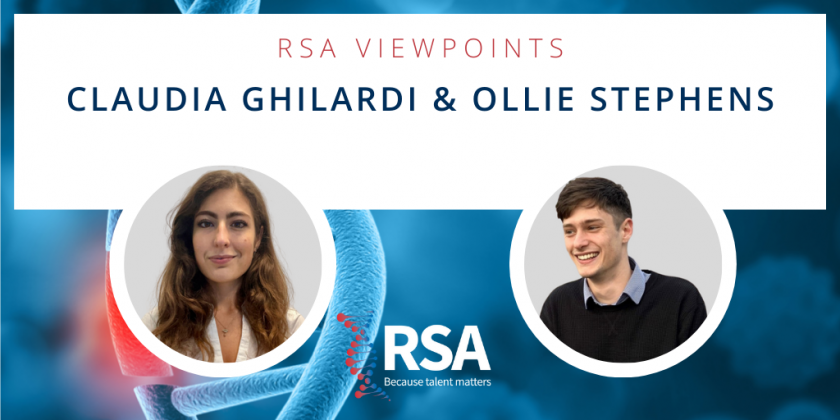A Brave New World – The Emerging Scene of Medicinal Psychedelics

On the 11th of May, the first ever PSYCH Symposium took place in London. Industry leaders converged at the National Gallery to promote access to psychedelic healthcare across Europe. Naturally, we sent one of our own to get all the latest information on psychedelic healthcare medicine. Topics included the industry expansion, its current limitations and hurdles, and the future innovations and benefits that this developing field will bring, with a particular focus on the impact on the mental health crisis.
Claudia Ghilardi, one our researchers, attended this event and shares her thoughts and insights in this article. Alongside Claudia, Ollie Stephens – another member of our research team, with a keen interest in the therapeutic potential of psychedelics – also contributes with the RSA Insight section. We hope you will all enjoy the fantastic insights they have in store for you.
The Creation and Movement of Talent within Psychedelics
For some time now – within the world of life sciences – we have been experiencing a major shift in talent location; particularly significant is the movements made by both individuals and (primarily) companies from the USA and Canada to the UK.
BioMind (a leading company in artificial intelligence) is a prime example of this as we observe their headquarters performing this exact move. Combined with the fact that the UK is considered to be the current lifeblood of biotech, it is no wonder that this increase in talent is beginning to show; even less of a surprise is that, as a result of this, this expansion is also crossing into Europe. Their revolutionary approach is slowly gaining traction and attracting professionals keen to move from the canonical neurology and psychiatry field.
This also highlights the need to create a specialised workforce and companies are using various methods to support their talent growth including the creation of graduate schemes.
When we then come to talk about psychedelics, the future begins to seem a little brighter. With this growth in presence, skill, and ability, it would be prudent to keep a close eye on how the psychedelic scene will progress. Especially regarding the hurdles in training suitable therapeutic professionals.
The Integration of Therapy & Psychedelics
As a result, the biggest challenges posed to these is set by the need to understand the perfect combination of pharmacological and psychological therapy, as the benefits have historically only been looked at in tandem and for now seem to be inseparable. Industry and research are now focused on understanding the winning combination.
Therapy has been at the forefront of this scene to allow patients full utilisation of these drugs, whilst aiming to keep the environment controlled and safe. Of course, when subjects are under the effects of chemicals such as Psilocybin – the active chemical in “magic mushrooms” – things can become hard to focus on, and many patients can be left vulnerable for up to 8 hours. This simply isn’t a method destined for success.
These compounds are the key ingredient for allowing this process to reach a fruitful conclusion. Limiting the time that these effects are present – such as reducing the effects of Psilocybin from 8 hours to 2 hours via deuteration – can allow us a few steps closer to realising the beneficial effects that psychedelics can offer.
Firstly, it can allow the effects of these psychedelics to fall closer in line with standard therapy session time. Secondly, it could also be a positive step in reducing patient vulnerability, by providing a much more controlled environment.
Employing Pharmaconeuromics is one of the best chances for understanding how best to integrate specific therapies for the use of these compounds: the idea that we will be able to quantify treatment progress and response, leading to tailored therapies and more effective outcomes.
A great example of this occurred between Cybin, a biopharmaceutical company, and Kernel, a neuroimaging company, who worked to create a new imaging device known as “Flow”. They came to test their invention by examining the effects of Ketamine on the brain. This is an example of the great strides being taken by those working within this brave new world and could offer us even great insights, not just into how best to integrate medicinal psychedelics and therapy, but how we can progress our scientific endeavors.
RSA Insight
The Major Obstacles in Medicinal Psychedelic Development
When it comes to the development and delivery of psychedelics compounds, there are a few obstacles preventing this process from completing quickly, outside of the usual drug regulations, of course.
Psilocybin – as an example – is listed as a schedule 1 drug within the UK, meaning that it is not currently recognised as providing any medicinal value. Because of this, not only must companies deal with attaining these grants, but they must also combat legal and political roadblocks that are put in place because of this chemical’s status.
It’s almost as if there is a vicious cycle in constant motion: there exists little physical evidence to support the suggestion that those psychedelics provide the benefits they do, and because of this it is increasingly difficult to perform the direct study that is needed.
For medicinal psychedelics to make true progress within the life sciences scene, we must first work on eliminating the stigma surrounding them and building the foundations for honest and productive investigation.